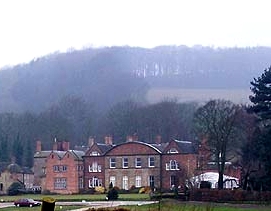
Tabley House is an English country house in Tabley Inferior, some 3 kilometres (1.9 mi) to the west of the town of Knutsford, Cheshire. The house is recorded in the National Heritage List for England as a designated Grade I listed building. It was built between 1761 and 1769 for Sir Peter Byrne Leicester, to replace the nearby Tabley Old Hall, and was designed by John Carr. The Tabley House Collection exists as an exhibition showcased by the University of Manchester.

Major-General Henry Gladwin was a British army officer in colonial America and the British commander at the Siege of Fort Detroit during Pontiac's Rebellion in 1763. He served in the disastrous campaign of Edward Braddock and in other actions in the French and Indian War but is best remembered for his defense of Detroit in Pontiac's Rebellion.

Woolley Hall is a country house in Woolley, West Yorkshire, England. It is a Grade II* listed building.

This is a list of Sheriffs of Derbyshire from 1567 until 1974 and High Sheriffs since.

Catton Hall is a country house near the boundary between Derbyshire and Staffordshire, within the civil parish of Catton. It gives its postal address as Walton-on-Trent although there was a village of Catton at one time. It is a Grade II* listed building.

Tissington Hall is an early 17th-century Jacobean mansion house in Tissington, near Ashbourne, Derbyshire. It is a Grade II* listed building.

Hilton Hall is an 18th-century mansion house now in use as an Office and Business Centre at Hilton, near Wolverhampton, in Staffordshire. It is a Grade I listed building.

Duffield Hall is a 17th-century country house situated in the Amber Valley, Derbyshire and the former headquarters of the Derbyshire Building Society. It is a Grade II* listed building.

Thomas Chambers Hine was an architect based in Nottingham.

Hopton Hall is an 18th-century country house at Hopton, near Wirksworth, Derbyshire. It is a Grade II listed building.

Hassop Hall is a 17th-century country house near Bakewell, Derbyshire, which was operated as a hotel until it closed on 29 September 2019. It is a Grade II* listed building.

Longford Hall is a 16th-century country house at Longford in the Dales district of Derbyshire, England. It is a Grade II* listed building.

Walton Hall is an 18th-century country house situated in the village of Walton on Trent, Derbyshire. It is a Grade II* listed building but is in slow decay and is officially registered on the Buildings At Risk Register.
Walton Hall is a late 18th-century country house, now a farmhouse, situated at Foljambe Avenue, Walton, Chesterfield. It is a Grade II listed building.
Whitwell Old Hall is an early 17th-century manor house at Whitwell, Derbyshire. It is a Grade II* listed building.

Parwich Hall is a privately owned 18th-century mansion house at Parwich, near Ashbourne, Derbyshire Dales. It is a Grade II* listed building.

Tyttenhanger House is a 17th-century country mansion, now converted into commercial offices, at Tyttenhanger, near St Albans, Hertfordshire. It is a Grade I listed building.

Hartington Hall is a much altered and extended 17th-century manor house at Hartington, Derbyshire, now a youth hostel.

Carnfield Hall is a privately owned country house located at South Normanton, near Alfreton in Derbyshire, England. It is a Grade II* listed building. The estate includes around ninety acres of park and ancient woodland.
Brackenfield is a civil parish in the North East Derbyshire district of Derbyshire, England. The parish contains 15 listed buildings that are recorded in the National Heritage List for England. Of these, one is listed at Grade II*, the middle of the three grades, and the others are at Grade II, the lowest grade. The parish contains the village of Brackenfield and the surrounding area. The most important building in the parish is Ogston Hall, a country house, that is listed together with associated structures. The other listed buildings are farmhouses and farm buildings, a church and its lychgate, a ruined chapel, a public house, a wall containing a gravestone and a guidepost, and a railway bridge.


















